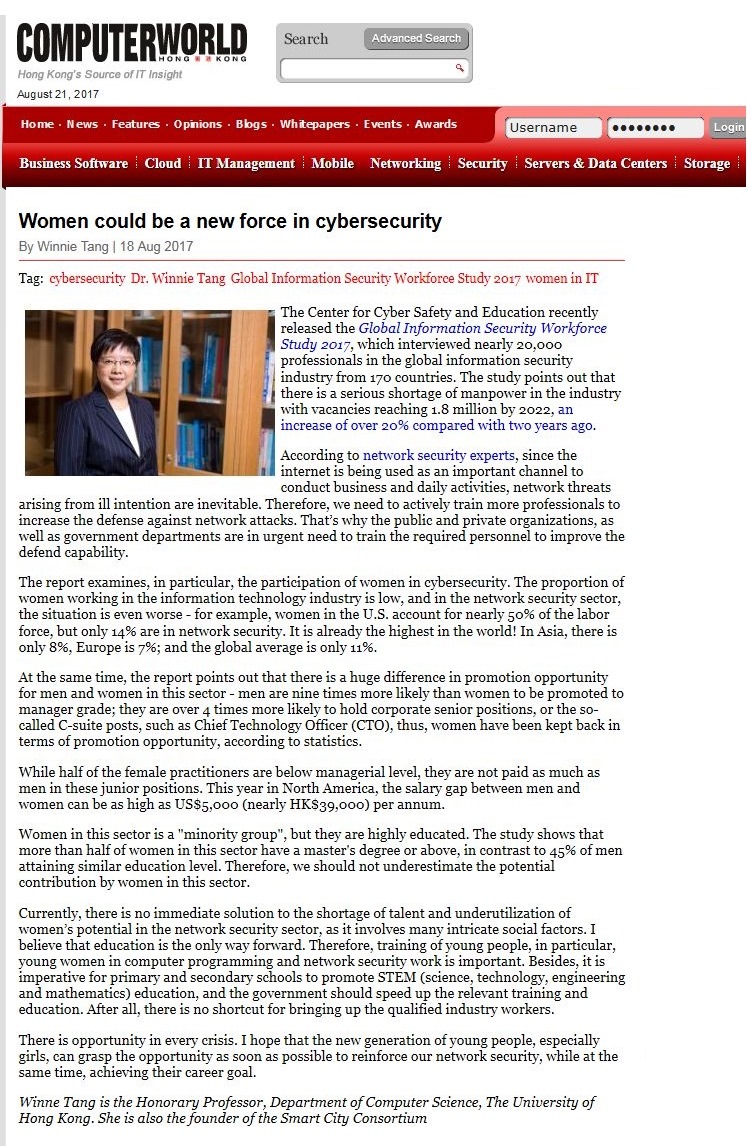網上版請按此

Women could be a new force in cybersecurity
The Center for Cyber Safety and Education recently released the Global Information Security Workforce Study 2017, which interviewed nearly 20,000 professionals in the global information security industry from 170 countries. The study points out that there is a serious shortage of manpower in the industry with vacancies reaching 1.8 million by 2022, an increase of over 20% compared with two years ago.
According to network security experts, since the internet is being used as an important channel to conduct business and daily activities, network threats arising from ill intention are inevitable. Therefore, we need to actively train more professionals to increase the defense against network attacks. That's why the public and private organizations, as well as government departments are in urgent need to train the required personnel to improve the defend capability.
The report examines, in particular, the participation of women in cybersecurity. The proportion of women working in the information technology industry is low, and in the network security sector, the situation is even worse - for example, women in the U.S. account for nearly 50% of the labor force, but only 14% are in network security. It is already the highest in the world! In Asia, there is only 8%, Europe is 7%; and the global average is only 11%.
At the same time, the report points out that there is a huge difference in promotion opportunity for men and women in this sector - men are nine times more likely than women to be promoted to manager grade; they are over 4 times more likely to hold corporate senior positions, or the so-called C-suite posts, such as Chief Technology Officer (CTO), thus, women have been kept back in terms of promotion opportunity, according to statistics.
While half of the female practitioners are below managerial level, they are not paid as much as men in these junior positions. This year in North America, the salary gap between men and women can be as high as US$5,000 (nearly HK$39,000) per annum.
Women in this sector is a "minority group", but they are highly educated. The study shows that more than half of women in this sector have a master's degree or above, in contrast to 45% of men attaining similar education level. Therefore, we should not underestimate the potential contribution by women in this sector.
Currently, there is no immediate solution to the shortage of talent and underutilization of women's potential in the network security sector, as it involves many intricate social factors. I believe that education is the only way forward. Therefore, training of young people, in particular, young women in computer programming and network security work is important. Besides, it is imperative for primary and secondary schools to promote STEM (science, technology, engineering and mathematics) education, and the government should speed up the relevant training and education. After all, there is no shortcut for bringing up the qualified industry workers.
There is opportunity in every crisis. I hope that the new generation of young people, especially girls, can grasp the opportunity as soon as possible to reinforce our network security, while at the same time, achieving their career goal.
Dr. Winnie Tang
Honorary Professor, Department of Computer Science, The University of Hong Kong